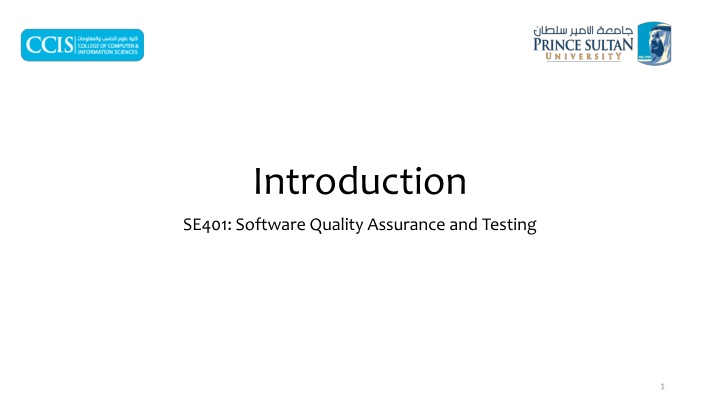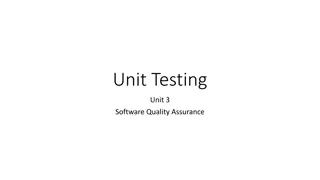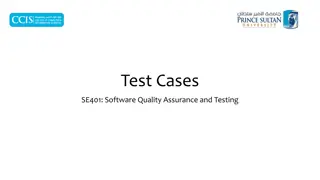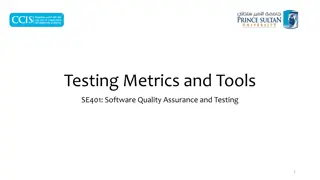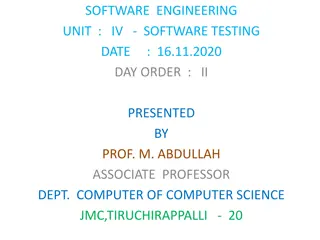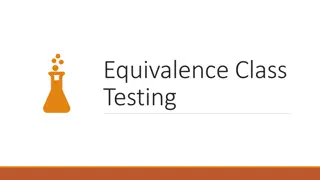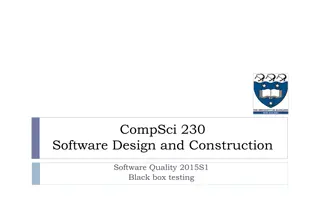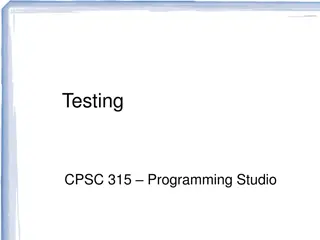Importance of Software Testing in Ensuring Quality
Software testing plays a critical role in ensuring the quality and reliability of software systems. This article highlights various real-world examples of catastrophic failures caused by software bugs, emphasizing the importance of thorough testing practices. It also discusses the economic impact of poor software quality, underscoring the need for robust testing processes to prevent costly failures. Additionally, a case study of the Ariane 5 launch vehicle illustrates the consequences of overlooking testing in high-stakes situations.
Download Presentation

Please find below an Image/Link to download the presentation.
The content on the website is provided AS IS for your information and personal use only. It may not be sold, licensed, or shared on other websites without obtaining consent from the author.If you encounter any issues during the download, it is possible that the publisher has removed the file from their server.
You are allowed to download the files provided on this website for personal or commercial use, subject to the condition that they are used lawfully. All files are the property of their respective owners.
The content on the website is provided AS IS for your information and personal use only. It may not be sold, licensed, or shared on other websites without obtaining consent from the author.
E N D
Presentation Transcript
Introduction SE401: Software Quality Assurance and Testing 1
Software is Everywhere 10/9/2024 2
Outline Why is testing necessary? What is testing? Testing Myths Software Testing Terminologies Test principles Fundamental test process The psychology of testing Limitations of Software Testing 3
Why Software Testing is Important? China Airlines Airbus A300 Crashed due to a software bug on April 26, 1994, killing 264 innocent live 5
Why Software Testing is Important? Canada's Therac-25 radiation therapy machine Malfunctioned in 1985 due to software bug and delivered lethal radiation doses to patients, leaving 3 people dead and critically injuring 3 others. 6
Why Software Testing is Important? $1.2 billion military satellite launch Failed In April of 1999 because of a software bug. The costliest accident in history 7
Why Software Testing is Important? US Bank Accounts A software bug caused 823 customers to be credited $920 million 8
Economic Impact The Cost of Poor Software Quality in the US 2020 Report by CISQ Consortium for Information & Software Quality: The total Cost of Poor Software Quality (CPSQ) in the US is $2.08 trillion Operational failures 1.56 trillion Legacy systems 520 billions We want software systems to be reliable Testing is how, in most cases, we find out if they are 9
A Case Study: Ariane 5 Launch Vehicle European expendable launch system Double the payload capacity of its predecessor Ariane 4 113 successful launches, 3 failures Flight 501, maiden launch, June 4, 1996,12:34pm 10
Case Study Ariane 5: What Happened? T0 - T0 + 36s : normal Within SRI 2: BH (Bias Horizontal) > 215 convert_double_to_int(BH) fails! exception SRI -> crash SRI 2 & 1 OBC disoriented angle > 20 , huge aerodynamics constraints boosters separating... T0 + 39s: self destruction cost: 500M 11
Case Study Ariane 5: Why Did It Happen? Not a programming error unprotected conversion = design decision (~1980) Not a design error Justified against Ariane 4 trajectory & RT constraints Problem with integration testing Theoretically detectable. But huge test space vs. limited resources Furthermore, SRI useless at this stage of the flight! Reuse of a component with a hidden constraint Precondition : abs(BH) < 32768.0 Valid for Ariane 4, but no longer for Ariane 5 More powerful rocket 12
Case Study Ariane 5: Lessons Learned in Software Eng. Test! Test! Test! Test! Even when the code is reused. When reuse, ensure the assumptions are still valid. When write reusable code, document the assumptions. Write fail-safe code. Do not propagate errors. 13
Why Software Testing is Important? History is full of such examples. Look for more examples! Testing is important because software bugs could be expensive or even dangerous. Software bugs can potentially cause monetary and human loss, 14
Why Programs fail Congratulations! Your code is complete. It compiles. It runs Your program fails. How can this be? There is a defect in the code. When the code is executed, the defect causes bad behavior, which later becomes visible as a failure. Before a program can be debugged, we must set it up such that it can be tested that is, executed with the intent to make it fail. The first step in debugging is to reproduce the problem in question that is, to create a test case that causes the program to fail in the specified way. The first reason is to bring it under control, such that it can be observed. The second reason is to verify the success of the fix. Now you will have the fun of testing and debugging! 15
Why Do We Test? Testing is expensive. So are failures! What do we gain from that cost? Finding bugs Leading to Fixing bugs Raising the quality of the program or system we are testing 16
Trade-Offs of Cost and Failures Total Cost of Quality (CoQ) = Cost of Conformance (CoC) + Cost of Non-Conformance (CoNC) Cost of Conformance Prevention: quality planning, investment in tools, quality training Appraisal: testing, inspection Cost of Non-Conformance Internal failures: rework External failure: liability, loss of properties, loss of lives 17
Trade-Offs of Cost and Failures Testing adds to Cost of Conformance It must directly reduce Cost of Non-Conformance 18
Software systems context Software systems are an important part of life: Most people had experience with software not working as expected. If the SW system doesn t wok correctly, it can lead to problems like: Loss of money Loss of business reputation Injury or death 19
Causes of software defects Human Error Non-controllable events (i.e. environmental conditions) 20
Causes of software defects Both causes of errors produce defects( = faults, bugs) in the code. Defects, if executed, may result in failures of the SW system (the system will fail to do what it should). Failures can affect seriously the users of the SW system, i.e.: Break pedal not working Miscalculations in financial SW systems 21
Role of testing Testing has an important role in all stages of a SW product s life cycle: Planning Development Maintenance Operations 24
Role of testing To reduce the risk of problems occurring during operation To check if the SW system meets: legal requirements Industry specific standards To learn more about the SW system 25
Testing Measures the quality the SW in terms of defects found Functional aspects Non functional aspects (Reliability, Usability, Portability) If it s properly tested and a minimum of defects are found Creates confidence in the quality of the SW By understanding the root causes of defects, processes can be improved. This can prevent defects from reoccurring. Teaches us lessons to apply in future projects 26
What is Software Testing? It is a systematic process used to identify the correctness, completeness, and quality of developed software. It includes a set of activities conducted with the intent of finding errors in a software so it can be corrected before the product is released to the end users In simple words: Software testing is an activity that ensures the software system is defect free. It can be either done manually or using automated tools. 28
Definition of testing The process of testing all SW life-cycle activities: both static and dynamic, concerned with: planning, preparation and evaluation of : software products and related work products to: determine that they satisfy specified requirements demonstrate that they are fit for purpose detect defects. 29
Definition of testing Depending on the objectives of the test process, testing can be focused on Confirming that the SW system meets the requirements Causing as many failures as possible Checking that no defects have been introduced during changes Assessing the quality of the SW (with no intention of finding Finding defects reduces the probability of undiscovered defects Creating confidence in the level of quality Providing information for decision-making Preventing defects 30
Definition of testing Finding defects reduces the probability of undiscovered defects Creating confidence in the level of quality Providing information for decision-making Preventing defects 31
Myth #1 in Software Testing Q: What is the objective of software testing? A: Testing is to show that there are no errors/bugs/defects in the software. Fact: No!! The main objective of testing is to discover defects. Testing is a destructive activity. 33
Myth #2 in Software Testing Q: What is the objective of software testing? A: Testing is to ensure that the software does what it is supposed to do. Fact: Only partly true. Testing is also to ensure the software does not do what it is not supposed to do. 34
Myth #3 in Software Testing Q: How challenging is software testing? A: Testing is easier than design and implementation. Fact: Must consider all possible scenarios. Implied and unstated requirements and threats. Must be imaginative and creative. 35
Myth #4 in Software Testing Q: How challenging is software testing? A: Testing is an extremely creative and intellectually challenging task. 36
Test the Following Program The program reads in 3 integer values that represent the lengths of the sides of a triangle. The program prints a message that states whether the triangle is Equilateral (all 3 sides are equal) Isosceles (exactly 2 of the 3 sides are equal) Scalene (all 3 sides are of a different length) Write a set of test cases that you feel would adequately test this program. 38
How Will You Do It? Write a set of test cases that you feel would adequately test this program. How many cases are needed? How do you plan to test the program? Run it once and manually enter the values? Run it many times with different inputs? Run it with a file containing a set of lines with test values? 40
How will you do it? Smoke test. , aka Hello World! Check handling of inputs Illegal inputs text instead of integers Impossible inputs floating vs. integer Outrageous values infinities, max and min values Not in domain negative numbers, values outside specifications Input errors wrong input, e.g. mis-spellings Stress test multiple inputs without restart run program for long periods of time 41
Software Testing Terminologies 42
The Very First Software Bug A moth found trapped between points at Relay # 70, Panel F Mark II Aiken Relay Calculator Harvard University September 9, 1945. On display in Smithsonian 43
Failures Failures are deviation of the observed behavior of a system from its specification, i.e., its expected behavior. Failures can only be determined with respect to the specifications. Failures are concerned with the observed behavior and outcome of the system. 44
Defects Defectsare flaws in a system that can cause the system to fail to perform its required function e.g. an incorrect condition or statement. Defects are concerned with specific parts or components of the system. Defects are synonymous with faults, bugs. 45
Errors Errors are human actions that result in a fault or defect in the system. Errors are concerned with the underlying causes of the defects. Errors are synonymous with mistakes. 46
The Relations among Failures, Defects, and Errors A human being makes an error (mistake) can occur in design, coding, requirements, even testing. An error can lead to a defect (fault) can occur in requirements, design, or program code. If a defect in code is executed, a failure may occur. Failures only occur when a defect in the code is executed. Not all defects cause failures all the time. Defects occur because human beings are fallible Failures can be caused by environmental conditions as well. 47
Failures, Defects, and Errors An example: For any integer n, square (n) = n*n. int square (int x) { return x*2; } Error: should be x^2 square (3) = 6 A defect A failure 48
Failures, Defects, and Errors An example: For any integer n, square (n) = n*n. int square (int x) { return x*2; } square (2) = 4 Correct result Not a failure A defect 49
Test Cases Terminology Test Case Verdicts Pass The test case execution was completed The function being tested performed as expected Fail The test case execution was completed The function being tested did not perform as expected Error The test case execution was not completed, due to an unexpected event, exceptions, or improper set up of the test case, etc. 50
